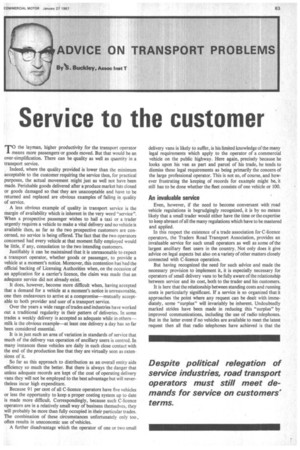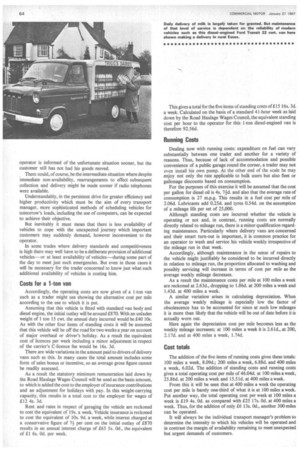Service to the customer
Page 65

Page 66

If you've noticed an error in this article please click here to report it so we can fix it.
TO the layman, higher productivity for the transport operator means more passengers.or goods moved. But that would he an over-simplification. There can be quality as well as quantity in a transport service.
Indeed, where the quality provided is lower than the minimum acceptable to the customer requiring the service then, for practical purposes, the actual movement might just as well not have been made. Perishable goods delivered after a produce market has closed or goods damaged so that they are unacceptable and have to be returned and replaced are obvious examples of failing in quality of service.
A less obvious example of quality in transport service is the margin of availability which is inherent in the very word "service". When a prospective passenger wishes to hail a taxi or a trader urgently requires a vehicle to make a vital delivery and no vehicle is available then, as far as the two prospective customers are concerned, no service is being offered. The fact that the two operators concerned had every vehicle at that moment fully employed would be little, if any, consolation to the two intending customers.
Justifiably it can be maintained that it is unreasonable to expect a transport operator, whether goods or passenger, to provide a vehicle at a moment's notice. Moreover, this contention hag had the official backing of Licensing Authorities when, on the occasion of an application for a carrier's licence, the claim was made that an adequate service did not already exist.
It does, however, become more difficult when, having accepted that a demand for a vehicle at a moment's notice is unreasonable, one then endeavours to arrive at a compromise—mutually acceptable to both provider and user of a transport service.
Over the years a wide range of trades and industries have worked out a traditional regularity in their pattern of deliveries. In some trades a weekly delivery is accepted as adequate while in others— milk is the obvious example—at least one delivery a day has so far been considered essential.
It is in just such an area of variation in standards of service that much of the delivery van operation of ancillary users is centred. In many instances these vehicles are daily in such close contact with the end of the production line that they are virtually seen as extensions of it.
So far as this approach to distribution as an overall entity aids efficiency so much the better. But there is always the danger that unless adequate records are kept of the cost of operating delivery vans they will not be employed to the best advantage but will nevertheless incur high expenditure.
Because 91 per cent of all C-licence operators have five vehicles or less the opportunity to keep a proper costing system up to date is made more difficult. Correspondingly, because such C-licence operators are in a relatively small way of business themselves, they will probably be more than fully occupied in their particular trades. The combination of these circumstances unfortunately only too often results in uneconomic use of vehicles.
A further disadvantage which the operator of one or two small delivery vans is likely to suffer, is his limited knowledge of the many legal requirements which apply to the operator of a commercial vehicle on the public highway. Here again, precisely because he looks upon his van as part and parcel of his trade, he tends to dismiss these legal requirements as being primarily the concern of the large professional operator. This is not so, of course, and however frustrating the keeping of records for example might be, it still has to be done whether the fleet consists of one vehicle or 100.
An invaluable service
Even, however, if the need to become conversant with road vehicle regulations is begrudgingly recognized, it is by no means likely that a small trader would either have the time or the expertise to keep abreast of all the many regulations which have to be mastered and applied.
In this respect the existence of a trade association for C-licence operators, the Traders Road Transport Association, provides an invaluable service for such small operators as well as some of the largest ancillary fleet users in the country. Not only does it give advice on legal aspects but also on a variety of other matters closely connected with C-licence operation.
But having recognized the need for such advice and made the necessary provision to implement it, it is especially necessary for operators of small delivery vans to be fully aware of the relationship between service and its cost, both to the trader and his customers.
It is here that the relationship between standing costs and running costs is particularly significant. If a service is so organized that it approaches the point where any request can be dealt with immediately, some "surplus" will invariably be inherent. Undoubtedly marked strides have been made in reducing this "surplus" by improved communications, including the use of radio telephones. But in the latter event if no vehicles are available to meet the latest request then all that radio telephones have achieved is that the operator is informed of the unfortunate situation sooner, but the customer still has not had his goods moved.
There could, of course, be the intermediate situation where despite immediate non-availability, rearrangements to effect subsequent collection and delivery might be made sooner if radio telephones were available.
Understandably, in the persistent drive for greater efficiency and higher productivity which must be the aim of every transport manager, more sophisticated methods of scheduling vehicles for tomorrow's loads, including the use of computers, can be expected to achieve their objective.
But inevitably it must mean that there is less availability of vehicles to cope with the unexpected journey which important customers may suddenly demand, however inconvenient to the operator.
In some trades where delivery standards and competitiveness is high there may well have to be a deliberate provision of additional vehicles—or at least availability of vehicles—during some part of the day to meet just such emergencies. But even in those cases it will be necessary for the trader concerned to know just what such additional availability of vehicles is costing him.
Costs for a 1-ton van Accordingly, the operating costs are now given of a 1-ton van such as a trader might use showing the alternative cost per mile according to the use to which it is put.
Assuming that this vehicle is fitted with standard van body and diesel engine, the initial outlay will be around £870. With an unladen weight of 1 ton 15 cwt. the annual duty incurred would be £40 10s. As with the other four items of standing costs it will be assumed that this vehicle will be off the road for two weeks a year on account of major overhaul or driver's holiday. As a result the equivalent cost of licences per week including a minor adjustment in respect of the carrier's C-licence fee would be 16s. 3d.
There are wide variations in the amount paid to drivers of delivery vans such as this. In many cases the total amount includes some form of sales bonus or incentive, so an average gross figure cannot be readily assessed.
As a result the statutory minimum remuneration laid down by the Road Haulage Wages Council will be used as the basic amount, to which is added the cost to the employer of insurance contributions and an adjustment for holidays with pay. In this weight-carrying capacity, this results in a total cost to the employer for wages of £12 4s. 3d.
Rent and rates in respect of garaging the vehicle are reckoned to cost the equivalent of 19s. a week. Vehicle insurance is reckoned to cost the equivalent of 10s. 9d. a week, while interest charged at a conservative figure of 71 per cent on the initial outlay of £870 results in an annual interest charge of £65 5s. Od., the equivalent of £1 6s. Od. per week. This gives a total for the five items of standing costs of £15 16s. 3d. a week. Calculated on the basis of a standard 41-hour week as laid down by the Road Haulage Wages Council, the equivalent standing cost per hour to the operator for this 1-ton diesel-engined van is therefore 92.56d.
Running Costs Dealing now with running costs: expenditure on fuel can vary substantially between one trader and another for a variety of reasons. Thus, because of lack of accommodation and possible convenience of a public garage round the corner, a trader may not even install his own pump. At the other end of the scale he may enjoy not only the rate applicable to bulk users but also fleet or gallonage discounts based on consumption.
For the purposes of this exercise it will be assumed that the cost per gallon for diesel oil is 4s. 7/cl. and also that the average rate of consumption is 27 m.p.g. This results in a fuel cost per mile of 2.06d. Lubricants add 0.25d. and tyres 0.54d. on the assumption of a mileage life per set of 25,000.
Although standing costs are incurred whether the vehicle is operating or not and, in contrast, running costs are normally directly related to mileage run, there is a minor qualification regarding maintenance. Particularly where delivery vans are concerned and their smart turn-out is important, it is common practice for an operator to wash and service his vehicle weekly irrespective of the mileage run in that week.
Accordingly, although maintenance in the sense of repairs to the vehicle might justifiably be considered to be incurred directly in relation to mileage run, the proportion allocated to washing and possibly servicing will increase in terms of cost per mile as the average weekly mileage decreases.
As a result the maintenance costs per mile at 100 miles a week are reckoned at 2.63d., dropping to 1.86d. at 200 miles a week and 1.43d. at 400 miles a week.
A similar variation arises in calculating depreciation. When the average weekly mileage is especially low the factor of obsolescence has to be accounted for since at such low mileages it is more than likely that the vehicle will be out of date before it is actually worn out.
Here again the depreciation cost per mile becomes less as the weekly mileage increases; at 100 miles a week it is 2.61d., at 200, 2.17d. and at 400 miles a week, 1.74d.
Cost totals The addition of the five items of running costs gives these totals: 100 miles a week, 8.09d.; 200 miles a week, 6.88d. and 400 miles a week, 6.02d. The addition of standing costs and running costs gives a total operating cost per mile of 46.04d. at 100 miles a week, 25.86d. at 200 miles a week and 15.51d. at 400 miles a week.
From this it will be seen that at 400 miles a week the operating cost per mile is barely one-third of what it is at 100 miles a week. Put another way, the total operating cost per week at 100 miles a week is £19 4s. Od. as compared with £25 17s. Od. at 400 miles a week. Thus, for the addition of only £6 13s. Od., another 300 miles can be operated.
It will always be the individual transport manager's problem to determine the intensity to which his vehicles will be operated and in contrast the margin of availability remaining to meet unexpected but urgent demands of customers.












































































































